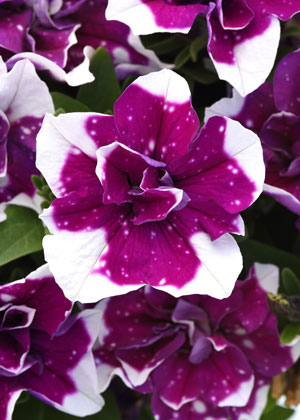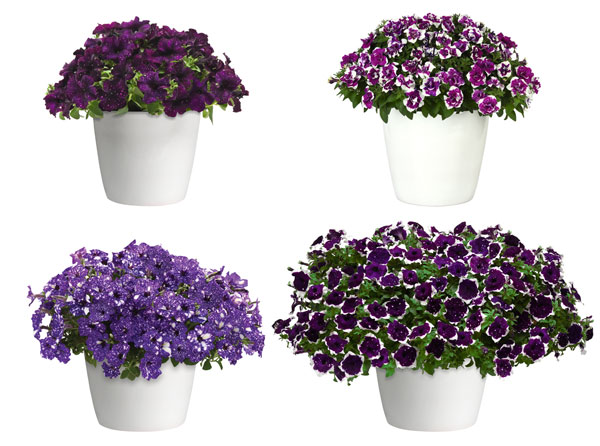12/1/2023
Reach for the (Double) Stars
Gary Vollmer

I wistfully remember the pure enthusiasm surrounding the 2016 Selecta One California Spring Trials. It was the year we officially launched Petunia Headliner Night Sky—the first Sky Petunia that brought a new pattern into the industry lexicon. Night Sky was everyone’s delight and definitely the No.1 flower of the launch event.
The breeding innovation story behind Night Sky is that it was a genetic mutation that changed the pigment distribution within the petals, which resulted in irregular pigmentation patterns that mimicked a constellation-filled night sky with stars and galaxies to enjoy.
Selecta One breeders then refined and stabilized this unique genetic trait through selective breeding. One of the challenges of being “first” is to understand all of the environmental factors that can alter the pattern. Through culture trials, tech teams discovered that lower night temperatures result in more prominent white specks, and warmer night temperatures reduce the sky pattern. In addition, certain PGR applications (B-Nine) can lead to blooms whitening, which was less than ideal.
Since those trials, stabilizing more variants of patterned petunias has been effortless and many more varieties joined the assortment. In 2021, Selecta One increased its Sky Petunia assortment from three to six varieties while also branching out into other plant habits and series. The Main Stage large-stature petunia series was the first expansion, followed by Starlet in the compact form in 2022.
Sales (and social media!) have shown that the sky pattern brings excitement into the world of petunias. Each bloom is unique with its smattering of “stars” and the appeal is real for shoppers in the marketplace.
Now for spring 2024, the industry has its first double sky pattern petunia with SweetSunshine Magenta Sky. The blooms of this pioneering variety are intricate and complex. They present in a double-layered structure with a white picotee edge and the famous spotted sky pattern.
SweetSunshine Magenta Sky is a versatile variety, too. Growers can produce it for monoculture pots, gallons or hanging baskets, or they can use it within combinations. The series plays well with other sun-loving plants due to its medium vigor and mounded habit.
In this article, I’ll share technical tips on how to grow and finish the best-looking double sky petunia plants to help you build a complete program around this high-profile pattern.
Rooting guidelines
The average propagation time for SweetSunshine Double Petunias is four weeks. Selecta One recommends starting your unrooted cuttings in a cell size of 25 mm. No rooting hormone is required. Provide seven to nine average days with mist.
There is no pinch in propagation, however, an early PGR treatment is recommended for vigorous products seven to 10 days after sticking. Apply a second treatment, if needed. Use sprays only; cover the plants and avoid run-off as much as possible, and test before use.
Rooting & finishing
Provide a media pH of 5.4 to 5.8 with best results achieved if media with the correct pH is used starting with propagation.
Start with a low concentration of fertilizer 250 to 300 ppm Nitrogen/EC 2.0 to 2.4 after roots show and increase with plant development to the recommended levels.
Keep cells constantly moist. In general, avoid drying out or overwatering the substrate, as this will affect plant quality and finishing time. The root system will suffer when conditions change from one extreme to the other.
“Growing on the dry side” means letting the substrate become dry (substrate color turns light brown and starts to separate from the pot edge). “Keep constantly moist” means watering the plants just before substrate becomes dry. Water management in rooting and finishing is half the success and the best way to prevent root-bound diseases, improve performance and control plant quality.
Cool temperatures and high light levels will improve plant quality.
■ Day temperatures: 65 to 75F (18 to 24C)
■ Night temperatures: 50 to 60F (10 to 16C)
Provide light at 5,000 to 6,000 f.c. A pinch after transplant is recommended. For additional plant growth control, apply B-Nine 2,500 ppm (spray); Sumagic 20 to 30 ppm (spray)/Sumagic 0.5 ppm (drench); or Bonzi 2 to 4 ppm (drench). Scout for aphids, thrips, leafminer, white fly, powdery mildew and Pythium. Watch for iron deficiency as well.
Finishing guidelines
During rooting, keep soil temperature measured in the liner at 70F (21C) until cuttings are well-rooted. After planting the liner, keep temperature up until roots have developed nicely. Afterwards, follow the temperature recommendations below.
The use of “cool morning” treatment will improve plant quality, flower and foliage color, and plant habit. It will also harden the plants. Lower the temperature by 8 to 12 degrees F (4 to 6 degrees C) two hours before sunrise until two to three hours after sunrise. Start treatments after plants are rooted in, well-branched and cover the media (reaches the pot edges).
To avoid delayed flowering, keep the average daily temperature under a close watch, and if necessary, increase night temperatures. Finishing of the crop depends on the average day temperature. Positive or negative DIF methods, as well as “cool morning” can be used to further improve plant quality.
 You can view the full assortment of Selecta One Sky Petunias on our website at selectanorthamerica.com/SkyPetunias. It shows all the dramatic colors and shares the multiple plant habits available. Additional plant culture and videos are just a click away for more resource success.
You can view the full assortment of Selecta One Sky Petunias on our website at selectanorthamerica.com/SkyPetunias. It shows all the dramatic colors and shares the multiple plant habits available. Additional plant culture and videos are just a click away for more resource success.
The stars continue to shine bright for this attractive petunia pattern! Grow confidently and send the best plants to retail with ongoing support from Selecta One.

Clockwise from far left:
Petunia Starlet
The most compact size featuring a Sky Petunia, Starlet Midnight Sky has a deep, dark and moody purple base with bright white stars. Plants are grower-friendly and controlled, and well-matched for timing, vigor and habit.
Double Petunia SweetSunshine
The durable double blooms of SweetSunshine make excellent hanging baskets and will certainly catch eyes in stores with their frilly charm. The Magenta Sky variety is the first sky pattern in double petunias!
Petunia Main Stage
Huge blooms mark this vigorous, trailing petunia series. Main Stage Glacier Sky has a deep blue flower hue and a white picotee edge, speckled with white. The series has excellent summer performance.
Petunia Headliner
There are 10 Sky Petunias in this medium-vigor, semi-trailing series ranging from bright pinks and reds to dark burgundies and purples. The most recent introduction is Headliner Violet Sky with cream spots rather than white, which contrast beautifully on each bloom. GT
Gary Vollmer is Technical Manager for Selecta One North America.